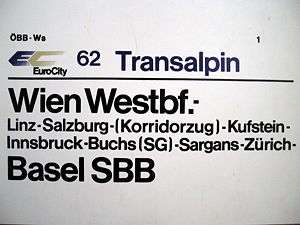Privileged transit traffic

Destination sign on a Transalpin EuroCity train
The privileged transit traffic or corridor traffic is traffic of one country across the territory of another country without usual customs and passport checks. The corresponding line of communication (usually a railway) is called the (privileged) traffic corridor and a train used in this kind of transit is called a corridor train (German: Korridorzug, Italian: Treno-corridoio).
Examples
A famous historical case of privileged transit was the arrival of Vladimir Lenin in a "sealed train car" from Germany to Russia in April 1917, amid World War I and Russian revolutionary activity.[1]
Estonia
- The road from Värska to Ulitina in Estonia, traditionally the only road to the Ulitina area, goes through Russian territory for one kilometre (0.6 mi) of its length, an area called Saatse Boot. This road has no border control, but there is no connection to any other road in Russia. It is not permitted to stop or walk along the road. This area is a part of Russia but is also a de facto part of the Schengen area. This arrangement started in 1991 and remains as of 2016.
Finland
- Finland leases the 19.6 km-long Russian part of the Saimaa Canal from Russia and is granted extraterritoriality rights. Russian visas are not required for just passing through the canal, but a passport is needed and it is checked at the border.
Poland
- A 1931 agreement between Poland and Romania for railway traffic between parts of Poland across Romania, between Zaleszczyki and Jasienów Polny. (Since 1945, both places are in Ukraine).[2]
- During the years between the world wars German trains could travel to and from East Prussia across the Polish Corridor with legally sealed doors, thereby relieving the passengers of obtaining Polish visas.
Russia
- Railway connection between mainland Russia and its Kaliningrad Oblast exclave across Lithuania. This is not privileged since normal passport and visa rules apply.
Germany
- Communication between East Prussia and mainland Germany across the Polish Corridor during the interwar period.
- Zittau–Görlitz from 1948, through Poland. This is still in operation as of 2014, but since 2007 the Schengen area removed all passport checks at the German–Polish border.
- In the cold war era, 1961-1990, Berlin U-Bahn and Berlin S-Bahn trains passed along sealed tunnels through East Berlin, without any check or any stop. The sealed stations were called ghost stations.
Austria
- Trains between Salzburg and Kufstein operated as privileged transit until 1997 when the Schengen area removed passport checks at this border.
- After World War II a 'corridor-train' service was established between Lienz and Innsbruck using the Puster Valley railway; this services lost importance after the Schengen Agreement, and was discontinued after 2013.
- During the Cold War trains with locked doors were allowed to go from northern to southern Burgenland by traversing a small part of western Hungary.
Czech Republic
- After World War II, in 1945, a 2.7 km part of the railway line Varnsdorf (CS) – Zittau (DE) – Liberec (CS) through Porajów became part of Poland and international traffic was stopped. In 1951, the Czechoslovak Railways restored Varnsdorf – Liberec connection based on an agreement with GDR and Poland; ČSD trains had no stop at Polish and German area. In 1964, a new treatment was signed. Since 1972, GDR and Czechoslovakia restored also standard international transport at this line. After broadening of the Schengen area, Varnsdorf – Liberec trains stop also at German area, but traffic through the Polish section is still based on the transit agreement. The Polish side gets a charge from the Czech side but neglects the Polish section and refuses proposals of Czech or German participation on the maintenance.[3]
References
This article is issued from
Wikipedia.
The text is licensed under Creative Commons - Attribution - Sharealike.
Additional terms may apply for the media files.